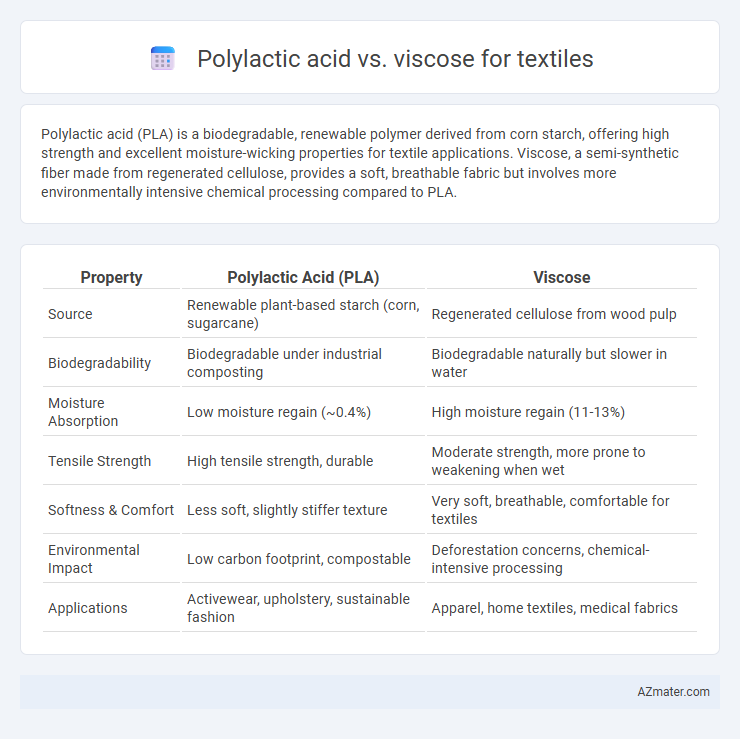Polylactic acid (PLA) is a biodegradable, renewable polymer derived from corn starch, offering high strength and excellent moisture-wicking properties for textile applications. Viscose, a semi-synthetic fiber made from regenerated cellulose, provides a soft, breathable fabric but involves more environmentally intensive chemical processing compared to PLA.
Table of Comparison
| Property | Polylactic Acid (PLA) | Viscose |
|---|---|---|
| Source | Renewable plant-based starch (corn, sugarcane) | Regenerated cellulose from wood pulp |
| Biodegradability | Biodegradable under industrial composting | Biodegradable naturally but slower in water |
| Moisture Absorption | Low moisture regain (~0.4%) | High moisture regain (11-13%) |
| Tensile Strength | High tensile strength, durable | Moderate strength, more prone to weakening when wet |
| Softness & Comfort | Less soft, slightly stiffer texture | Very soft, breathable, comfortable for textiles |
| Environmental Impact | Low carbon footprint, compostable | Deforestation concerns, chemical-intensive processing |
| Applications | Activewear, upholstery, sustainable fashion | Apparel, home textiles, medical fabrics |
Overview of Polylactic Acid (PLA) and Viscose
Polylactic Acid (PLA) is a biodegradable thermoplastic derived from renewable resources such as corn starch or sugarcane, offering eco-friendly alternatives to traditional synthetic fibers in textiles. Viscose, a semi-synthetic fiber made from chemically processed cellulose typically sourced from wood pulp, provides a soft, breathable fabric that mimics the feel of natural fibers. While PLA is valued for its compostability and strength, viscose is prominent for its versatility and moisture-absorbing properties in textile applications.
Raw Material Sources and Production Processes
Polylactic acid (PLA) is derived from renewable resources such as corn starch or sugarcane through fermentation, followed by polymerization into a biodegradable fiber, whereas viscose is produced from cellulose extracted primarily from wood pulp via chemical processing involving carbon disulfide and sodium hydroxide. The production of PLA has a lower environmental impact due to the use of biomass and fewer harmful chemicals, while viscose manufacturing relies heavily on intensive chemical treatments and generates significant effluents. PLA's origin in agricultural feedstocks supports sustainability goals, contrasting with viscose's dependence on deforestation risks and complex chemical recovery systems.
Environmental Impact: PLA vs Viscose
Polylactic acid (PLA) fibers are derived from renewable resources like cornstarch, resulting in lower greenhouse gas emissions and reduced reliance on fossil fuels compared to viscose, which is produced from wood pulp through chemically intensive processes that often involve harmful solvents. PLA's biodegradability under industrial composting conditions minimizes long-term environmental pollution, while viscose manufacturing contributes to deforestation, water pollution, and significant chemical waste challenges. Sustainable PLA production supports reduced carbon footprints and circular economy goals, contrasting with the environmental concerns linked to traditional viscose textile production.
Biodegradability and Compostability Comparison
Polylactic acid (PLA) offers superior biodegradability and compostability compared to viscose, breaking down into non-toxic lactic acid in industrial composting facilities within 1 to 3 months. Viscose, derived from cellulose, biodegrades slower and may leave chemical residues due to the use of toxic solvents during production, impacting its overall compostability. PLA's renewable resource base from corn starch and its certification under ASTM D6400 standards make it a more eco-friendly choice for sustainable textiles.
Mechanical Properties and Textile Performance
Polylactic acid (PLA) fibers exhibit higher tensile strength and better elasticity compared to viscose, making them more durable for textile applications requiring mechanical resilience. PLA offers excellent UV resistance and moisture management, enhancing textile performance in activewear and outdoor fabrics. Viscose, while softer and more breathable, tends to have lower abrasion resistance and mechanical strength, limiting its use in high-stress textile environments.
Dyeability and Colorfastness
Polylactic acid (PLA) fibers exhibit lower dye affinity compared to viscose, requiring specialized dyes and higher processing temperatures to achieve vibrant colors. Viscose demonstrates superior dyeability due to its hydrophilic nature, allowing for uniform dye uptake and a wide color range with standard reactive and direct dyes. Colorfastness in viscose generally surpasses PLA, maintaining color integrity through multiple washes, while PLA fibers can experience faster fading and color change under UV exposure.
Comfort and Wearability in Apparel
Polylactic acid (PLA) fibers offer moisture-wicking properties and excellent breathability, enhancing comfort by keeping the skin dry and cool during wear. Viscose provides a soft, smooth texture and good drape, contributing to a luxurious feel and ease of movement in apparel. While PLA excels in durability and moisture management, viscose outperforms in softness and breathability, making both fibers suitable depending on the desired comfort and wearability attributes.
Cost and Market Availability
Polylactic acid (PLA) fibers tend to be more expensive than viscose due to their bio-based production process and relatively limited manufacturing scale. Viscose, derived from wood pulp, has a well-established global supply chain, making it more widely available and cost-effective for textile applications. Market availability of PLA is growing but remains constrained compared to viscose, which dominates the market due to its lower cost and established production infrastructure.
Applications in Textile Industry
Polylactic acid (PLA) is widely used in the textile industry for eco-friendly apparel, offering biodegradability and moisture-wicking properties suitable for sportswear and activewear. Viscose, a versatile regenerated cellulose fiber, excels in producing soft, breathable fabrics ideal for casual wear, linings, and home textiles. PLA's lower environmental impact and biodegradability contrast with viscose's reliance on chemical processing, influencing material selection based on sustainability criteria and end-use performance.
Future Trends and Innovation in Sustainable Fibers
Polylactic acid (PLA) fibers, derived from renewable resources like corn starch, offer biodegradability and lower carbon footprints compared to conventional viscose, making them a focal point in sustainable textile innovation. Emerging production technologies for PLA aim to enhance fiber strength and moisture management, addressing previous limitations and expanding applications in performance wear and eco-friendly fashion. Viscose continues evolving through closed-loop manufacturing processes and recycled raw materials, but the shift towards bio-based polymers like PLA signals a future trend prioritizing circularity and reduced environmental impact in textile fibers.

Infographic: Polylactic acid vs Viscose for Textile
 azmater.com
azmater.com